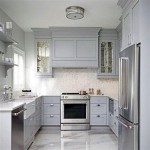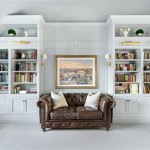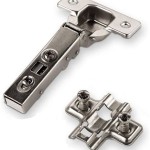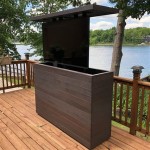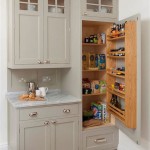How To Build Pull-Out Drawers For Kitchen Cabinets
The installation of pull-out drawers within existing kitchen cabinets represents a significant enhancement in functionality and accessibility. These drawers eliminate the need to strain and reach into the depths of cabinets, providing a convenient solution for storing and retrieving items. This article provides a detailed guide on constructing and installing pull-out drawers, covering all necessary steps from measurement and material selection to assembly and final fitting.
Planning and Preparation
Accurate planning is crucial for a successful pull-out drawer installation. This phase involves meticulous measurement, careful material selection, and a clear understanding of the desired functionality and aesthetic.
The first step involves measuring the interior dimensions of the cabinets. These measurements determine the maximum size of the drawer boxes. Specifically, the width, depth, and height of the cabinet's opening must be accurately recorded. It is imperative to subtract sufficient clearance for the drawer slides, typically ranging from ½ inch to 1 inch on each side. This allowance ensures smooth drawer operation without binding. Consider any obstructions within the cabinet, such as plumbing or structural elements, which may necessitate adjusting the drawer dimensions.
Next is the selection of appropriate materials. While various options exist, plywood and solid wood are the most common choices for drawer construction. Plywood offers stability and affordability, making it suitable for the drawer box's sides, bottom, and back. Baltic birch plywood is often preferred due to its void-free construction and strength. Solid wood, such as maple or poplar, can be used for drawer fronts, offering a more aesthetically pleasing appearance. The choice of wood species should complement the existing kitchen cabinetry. The thickness of the chosen material also impacts the drawer's durability and load-bearing capacity. Typically, ½-inch or ¾-inch plywood is used for the sides, bottom, and back, while ¾-inch solid wood is common for the drawer front.
Finally, consider the type of drawer slides to be used. These slides connect the drawer box to the cabinet, enabling smooth extension and retraction. Ball-bearing slides are a popular choice due to their durability and smooth operation. They are available in various load capacities, lengths, and features, such as soft-close mechanisms. Soft-close slides prevent the drawer from slamming shut, enhancing user experience and reducing wear and tear. Undermount slides offer a concealed installation, providing a cleaner aesthetic, while side-mount slides are more visible but often easier to install. The selection of drawer slides should be based on the drawer's intended load, the desired extension length, and the preferred aesthetic.
Construction of the Drawer Boxes
The construction of the drawer boxes involves cutting the selected materials to size, assembling the components, and ensuring squareness and structural integrity. Precise cuts and secure joinery are essential for smooth operation and long-term durability.
Begin by cutting the plywood or solid wood to the precise dimensions calculated during the planning phase. A table saw or circular saw with a guide is recommended for accurate cuts. Ensure that all pieces are square and free of splinters. The drawer box typically consists of four sides (two sides, a front, and a back) and a bottom. The dimensions of the sides determine the drawer's depth, while the dimensions of the front and back determine its width. The bottom is sized to fit within the assembled sides, front, and back.
Next is the assembly of the drawer box. Several joinery methods can be employed, including rabbet joints, dado joints, dovetail joints, and screw and glue construction. Rabbet joints and dado joints offer a strong and relatively simple method of joining the sides to the front and back. These joints involve cutting a groove (dado) or a recess (rabbet) into the wood to create a strong mechanical interlock. Dovetail joints are renowned for their strength and aesthetic appeal but require more advanced woodworking skills and specialized tools. Screw and glue construction is the simplest method, involving the use of wood screws and wood glue to join the components. Regardless of the chosen method, ensure that the joints are square and secure.
Apply wood glue to all joining surfaces before assembling the pieces. Clamp the assembled drawer box square and allow the glue to dry completely. The use of clamps ensures that the joints are tight and that the drawer box remains square during the drying process. Check the drawer box for squareness using a square or measuring the diagonals. If the diagonals are equal, the drawer box is square. Once the glue is dry, reinforce the joints with screws if necessary. Ensure that the screws are countersunk to prevent them from interfering with the drawer slides.
The drawer bottom is then attached to the assembled sides, front, and back. The bottom can be installed in a dado groove or simply glued and screwed to the bottom edges of the drawer box. Ensure that the bottom is flush with the bottom edges of the sides, front, and back. This provides a smooth surface for the drawer to slide on and prevents items from snagging on the bottom edge.
Installation of Drawer Slides and Drawer Boxes
The installation of drawer slides requires precise alignment and secure attachment. Improper installation can result in drawers that bind, stick, or fail to operate smoothly. Attaching the drawer front involves aligning it with the cabinet face and securing it to the drawer box.
The first step involves installing the drawer slides. The cabinet members of the drawer slides are attached to the interior sides of the cabinet, while the drawer members are attached to the sides of the drawer box. Accurate placement of the slides is crucial for smooth drawer operation. Refer to the manufacturer's instructions for specific installation guidelines. Use a level to ensure that the slides are mounted horizontally and at the same height on both sides of the cabinet. Mark the screw locations with a pencil and pre-drill pilot holes to prevent the wood from splitting. Secure the slides to the cabinet using wood screws. Ensure that the screws are of the appropriate length and that they are driven straight into the wood.
Next is to attach the drawer members of the slides to the drawer box. Again, refer to the manufacturer's instructions for specific placement guidelines. Ensure that the drawer members are mounted parallel to the sides of the drawer box and at the same height on both sides. Mark the screw locations with a pencil and pre-drill pilot holes. Secure the drawer members to the drawer box using wood screws. Ensure that the screws are of the appropriate length and that they are driven straight into the wood.
Then, test the drawer box by sliding it into the cabinet. If the drawer slides smoothly, proceed to the next step. If the drawer binds or sticks, check the alignment of the drawer slides and adjust as necessary. Ensure that the slides are properly lubricated to reduce friction. Silicone spray lubricant is often recommended for drawer slides.
Finally, attach the drawer front. Position the drawer front flush with the cabinet face and align it with the adjacent drawers. Use shims to achieve a consistent gap between the drawer front and the cabinet frame. Once the drawer front is properly aligned, secure it to the drawer box. This can be accomplished using screws driven through the drawer box into the back of the drawer front. Alternatively, adhesive can be used to bond the drawer front to the drawer box. Ensure that the adhesive is compatible with the materials being joined. Once the drawer front is securely attached, install a handle or knob. Choose a handle or knob that complements the existing cabinetry and that is comfortable to grip.
By following these detailed instructions, individuals with basic woodworking skills can successfully construct and install pull-out drawers in their kitchen cabinets, enhancing convenience and organization.

Diy Pull Out Cabinet Drawers Love Renovations

How To Make Simple Easy Sliding Shelves

How To Make Pull Out Shelves For Kitchen Cabinets Ron Hazelton

How To Make Simple Easy Sliding Shelves

Diy Pull Out Cabinet Drawers Love Renovations

Kitchen Storage Pull Out Pantry Shelves Diy Family Handyman

Kitchen Organization Pull Out Shelves In Pantry Remodelando La Casa

Diy Pull Out Cabinet Drawers Love Renovations

How To Easily Add Drawers Kitchen Cabinets Small Stuff Counts

10 Roll Outs For Kitchen Cabinets Ana White
Related Posts




